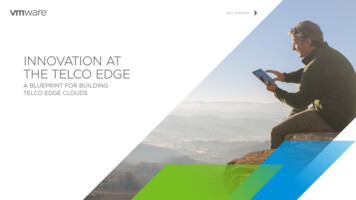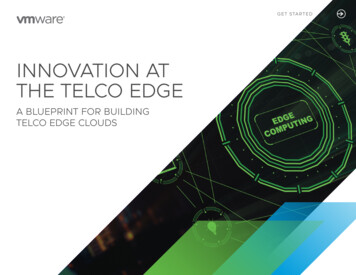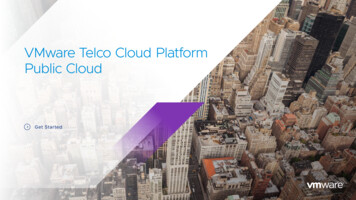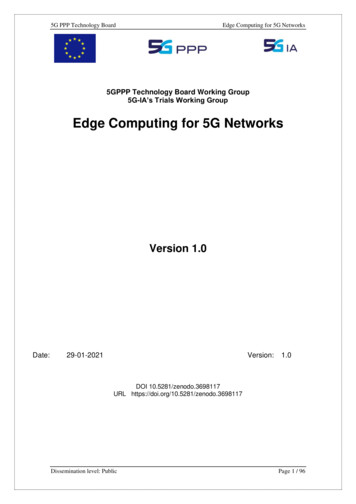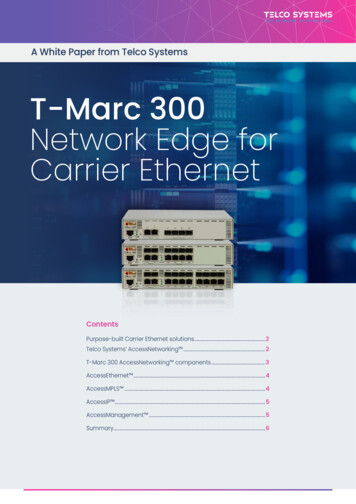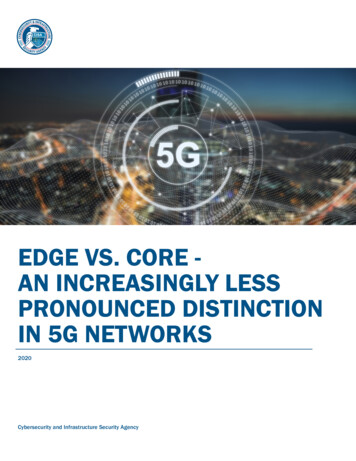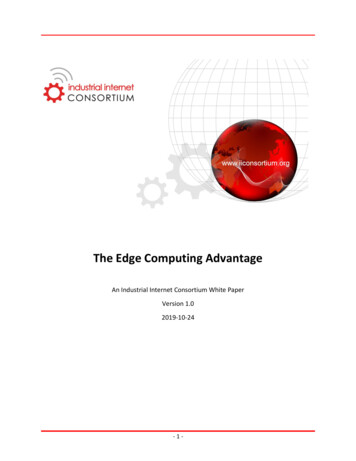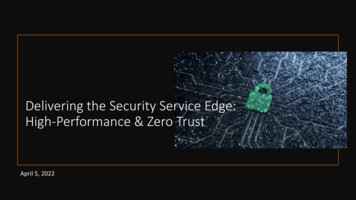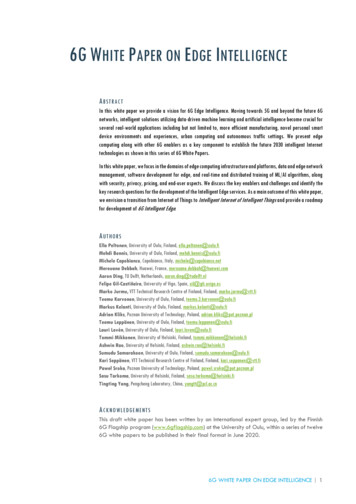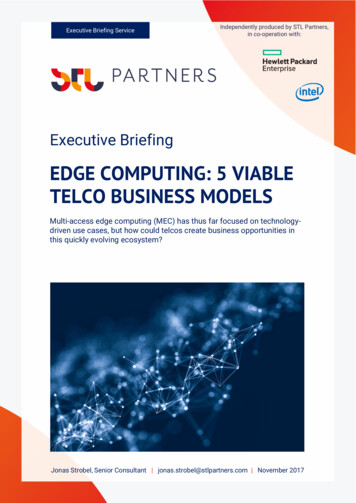
Transcription
Executive Briefing ServiceIndependently produced by STL Partners,in co-operation with:Executive BriefingEDGE COMPUTING: 5 VIABLETELCO BUSINESS MODELSMulti-access edge computing (MEC) has thus far focused on technologydriven use cases, but how could telcos create business opportunities inthis quickly evolving ecosystem?Jonas Strobel, Senior Consultant jonas.strobel@stlpartners.com November 2017
EDGE COMPUTING: 5 VIABLE TELCO BUSINESS MODELS NOVEMBER 2017PrefaceThe document has been prepared by independent research firm STL Partners, and commissioned byHewlett Packard Enterprise and Intel. It is based on STL Partners’ continuous research programmeinto the future telecoms operator and how to get there.This report should be read by CIOs, strategy executives, CTOs, CMOs, enterprise architects andplanning/operational staff communications service providers, information providers, softwarevendors, web/hosting firms, cable operators, ISPs, integrators, developers and similar organisations.Mentions of companies in this document are intended as illustrations of market evolution and are notintended as endorsements or product/service recommendations. STL PartnersEXECUTIVE BRIEFING2
EDGE COMPUTING: 5 VIABLE TELCO BUSINESS MODELS NOVEMBER 2017Executive summary With multi-access edge computing (MEC), telcos can make compute and storage capabilitiesavailable to customers at the edge of communications networks. This will mean that workloadsand applications are closer to customers, potentially enhancing experiences and enabling newservices and offers. There is a plethora of potential vertical and horizontal use cases (e.g. control and monitoring ofindustrial machinery; connected/autonomous vehicle functions; augmented reality (AR) andvirtual reality (VR) for gaming, entertainment or enterprise applications), but commercially-viablebusiness models to realise these use cases are still unclear. As an added complication, alternative edge computing concepts are emerging that potentiallycompete with telcos’ concept of MEC. Most notably, hyperscale cloud providers are movingbeyond the idea of centralised cloud by extending their platforms to the customer edge (e.g.gateways or servers on-premise) or even the device edge (e.g. IoT devices performing parts ofthe overall application logic themselves). With strong competition looming, telcos should explore what could be viable business models tosupport the many potential MEC use cases. For this we have defined five telco business modelsfor MEC:Source: STL Partners Dedicated edge hosting: The telco delivers and manages edge-located compute/storageresources, which are pre-installed and connected to the telco network. The customer/partnerruns its software, which could be for example a virtual content delivery network (CDN) or adistributed cloud stack, on top of the telco’s edge-enabled dedicated hardware resources. STL PartnersEXECUTIVE BRIEFING3
EDGE COMPUTING: 5 VIABLE TELCO BUSINESS MODELS NOVEMBER 2017 Edge IaaS/PaaS/NaaS: The telco in this business model operates in a similar manner to acloud provider, providing customers distributed compute and storage capabilities, a platformfor developing applications on the edge infrastructure and network services, as well as APIsand virtual network functions (VNFs) in an ‘as-a-service’ manner through a cloud portal asthe customer interface. Systems integration: The telco builds upon an existing SI business, offering custom turn-keysolutions for enterprise customers with specific requirements, which are (partially) met byMEC functionality. B2B2x solutions: The telco offers edge-enabled solutions to enterprise customers. As withexisting B2B solutions, these may be for the customer’s internal purposes, such as toimprove existing processes, or may contribute to an end-customer offering (B2B2X). Ingeneral, these solutions will be closer to an ‘off-the-shelf’ product than a totally bespokeoffering, thus requiring significantly less integration work than SI projects. End-to-end consumer retail applications: The telco plays high up the value chain, acting as adigital service provider for consumer applications. MEC-enabled services in this category willleverage the benefits of MEC, namely low latency, high throughput and context awareness, toprovide consumers with innovative applications (e.g. VR for live sports). With these business models, telcos can choose from a menu of options which fit their risk profileand existing capabilities. Indeed, some business models (e.g. Dedicated edge hosting) are a safebet for telcos, albeit with an overall limited impact on the business in the longer run. Otherbusiness models require telcos to invest more upfront and therefore take on more risks;however, such business models might become a significant source of revenue in the longerterm. To conclude, telcos do have options to counter the emerging competition in the edge computingspace. In order to avoid losing any ground, it is critical for individual telcos to begin identifyingand commercialising use cases and business models which are a good fit to their business. STL PartnersEXECUTIVE BRIEFING4
EDGE COMPUTING: 5 VIABLE TELCO BUSINESS MODELS NOVEMBER 2017Table of ContentsPreface . 2Introduction . 7The emerging edge computing ecosystem . 8Telcos’ MEC opportunity . 8Hyperscale cloud providers are an added complication for telcos . 9How should telcos position themselves? . 105 telco business models for MEC . 11Business model 1: Dedicated edge hosting . 12Business model 2: Edge IaaS/PaaS/NaaS . 15Business model 3: Systems integration . 17Business model 4: B2B2X solutions . 19Business model 5: End-to-end consumer retail applications . 21Mapping use cases to business models . 23Some business models will require a long-term view on the investment . 24Which business models are right for which operator and which operator division? . 26Conclusion . 28 STL PartnersEXECUTIVE BRIEFING5
EDGE COMPUTING: 5 VIABLE TELCO BUSINESS MODELS NOVEMBER 2017Table of FiguresFigure 1: Defining MEC . 7Figure 2: MEC potential benefits . 8Figure 3: Microsoft’s new mantra – “Intelligent Cloud, Intelligent Edge” . 10Figure 4: STL Partners has identified 5 telco business models for MEC . 11Figure 5: The dedicated edge hosting value chain. 13Figure 6: Quantified example – Dedicated edge hosting. 14Figure 7: The Edge IaaS/PaaS/NaaS value chain . 15Figure 8: Quantified example – Edge IaaS/PaaS/NaaS. 16Figure 9: The SI value chain . 17Figure 10: Quantified example – Systems integration . 18Figure 11: The B2B2X solutions value chain . 19Figure 12: Quantified example – B2B2x solutions . 20Figure 13: Graphical representation of the end-to-end consumer retail applications business model. 21Figure 14: Quantified example – End-to-end consumer retail applications . 22Figure 15: Mapping MEC business models to possible use cases . 23Figure 16: High IRR correlates with low terminal value . 24Figure 17: Telcos need patience for edge-enabled consumer applications to become profitable (breakeven only in year 5) . 25Figure 18: The characteristics and skills required of the MEC operator depend on the business models. 26 STL PartnersEXECUTIVE BRIEFING6
EDGE COMPUTING: 5 VIABLE TELCO BUSINESS MODELS NOVEMBER 2017IntroductionThe idea behind Multi-Access Edge Computing (MEC) is to make compute and storage capabilitiesavailable to customers at the edge of communications networks. This will mean that workloads andapplications are closer to customers, potentially enhancing experiences and enabling new servicesand offers. As we have discussed in our recent report, there is much excitement within telcos aroundthis concept: MEC promises to enable a plethora of vertical and horizontal use cases (e.g. leveraging lowlatency) implying significant commercial opportunities. This is critical as the whole industry istrying to uncover new sources of revenue, ideally where operators may be able to build asustainable advantage. MEC should also theoretically fit with telcos’ 5G and SDN/NFV deployments, which will runcertain virtualised network functions in a distributed way, including at the edge of networks. Inturn, MEC potentially benefits from the capabilities of a virtualised network to extract the fullpotential of distributed computing.Figure 1: Defining MECSource: STL PartnersHowever, despite the excitement around the potentially transformative impact of MEC on telcos,viablecommercial models that leverage MEC are still unclear and undefined. As an added complication, adiverse ecosystem around edge computing is emerging – of which telcos’ MEC is only one part.From this, the following key questions emerge: Which business models will allow telcos to realise the various potential MEC use cases in acommercially viable way? STL PartnersEXECUTIVE BRIEFING7
EDGE COMPUTING: 5 VIABLE TELCO BUSINESS MODELS NOVEMBER 2017 What are the right MEC business models for which telco? What is needed for success? What are the challenges?The emerging edge computing ecosystemTelcos’ MEC opportunityMEC is being discussed under a variety of use cases. These use cases on the one hand implyadvancements for existing applications such as content/application delivery, or caching by bringingthese closer to the user in a geographically distributed way. On the other hand, MEC is also seen asthe key enabler for emerging scenarios, such as: Control and monitoring of industrial machinery, sensors, robots (Industry 4.0) Connected/autonomous vehicle functions Augmented Reality (AR) and Virtual Reality (VR): gaming, entertainment, enterprise applications(such as unaccompanied remote worker support)Deployed through MEC, such use case scenarios can benefit from MEC-specific features such as lowlatency, network awareness and optimal allocation of resources. Therefore, MEC should yield benefitsfor both customers and the operator itself (see Figure 2 in detail).Figure 2: MEC potential benefitsSource: STL Partners STL PartnersEXECUTIVE BRIEFING8
EDGE COMPUTING: 5 VIABLE TELCO BUSINESS MODELS NOVEMBER 2017Hence, MEC in theory offers the opportunity for telcos to: Improve their network operations to achieve efficiencies and cost savings Differentiate their own service offerings through MEC capabilities Enable others to make use of distributed compute capabilitiesTo reap these opportunities, telcos and vendors have been trying to coordinate and integrate theirefforts, most notably through the ETSI Industry Specification Group for MEC (founded in 2014). Whilethe group’s work was initially focused on features such as standards for RAN-awareness, in thecontext of mobile edge computing, there has been a reorientation to also encompass fixed-networkedge computing (hence, multi-access edge computing). A first release of API standards has beenreleased in July 2017 to facilitate interoperability of MEC deployments.In another move towards interoperability, the ETSI group has recently signed a memorandum ofunderstanding with the OpenFog Consortium, an organisation which promotes the similar concept offog computing (a concept driven by several vendors, which is less focused than MEC on telcos’network access as part of the overall architecture). At first, both parties want to focus on standardisingAPIs to make it “easier for developers to create common architectures, unify management strategies,and write a single application software modules that run on both OpenFog and MEC architectures”.Hyperscale cloud providers are an added complication fortelcosRecently, it has become evident that the edge must not be understood as a concept that is purelyrelated to the telco network. In particular, hyperscale cloud providers such as Amazon Web Services(AWS) or Microsoft Azure have been very clear on their ambition to complement their centralised cloudservices with more distributed capabilities. On the one hand, this is an encouraging signal that thereis real demand for MEC. On the other, it represents an added challenge for telcos.In a move to “edge-enable” its existing AWS IoT Platform, Amazon launched AWS Greengrass in late2016. With AWS Greengrass, IoT applications can be run both in the centralised cloud and locally onan IoT device or gateway. AWS Greengrass utilises the same programming model as AWS cloud.However, the capabilities at the edge are tailored to support “serverless” application logic – that is tosay, less compute- and storage-intensive. Large parts of an IoT application might still run in the cloud,while there is also application logic deployed locally which performs certain analytical or controlfunctions (such as controlling interactions between local devices). In such a model, roundtrip latencyand bandwidth cost can be reduced by processing IoT data locally and not sending all informationback to the cloud.While Microsoft’s Azure IoT Edge provides similar capabilities as AWS Greengrass, the company haseven gone further recently: with the launch of Azure Stack, customers are now able to run the full Azurecloud environment not only in Microsoft’s centralised cloud but also on-premise on their own servers.This enables enterprises to make use of so-called hybrid cloud environments in which their own STL PartnersEXECUTIVE BRIEFING9
EDGE COMPUTING: 5 VIABLE TELCO BUSINESS MODELS NOVEMBER 2017premises represent the edge with all the potential benefits that come with localised compute (lowlatency, compliance, etc.).Both Amazon and Microsoft’s moves are facilitated by several trends which shift the economics infavour of more local and distributed compute and storage at the customer edge (e.g. gateways orservers on-premise) or even the device edge (e.g. IoT devices performing parts of the overallapplication logic themselves). These trends include: The growing proliferation of IoT applications which create masses of data that do not need tobe processed centrally. Advanced cloud platforms which now facilitate distributed compute models through capabilitiessuch as hybrid cloud computing (e.g. Azure Stack) or serverless computing (e.g. AWS Lambda).Figure 3 shows how Microsoft as a centralised cloud provider now incorporates the “intelligent”edge (which can be telecoms-agnostic) into their overall cloud vision statement. Chip technologies which make it possible to perform computational tasks economically on verysmall physical space – both for low-performance applications (e.g. through “system on a chip”architecture on mass IoT devices) as well as high-performance applications (e.g. throughmodern Graphics Processing Units for AI-dependent use cases such as autonomous cars).Figure 3: Microsoft’s new mantra – “Intelligent Cloud, Intelligent Edge”Source: MicrosoftHow should telcos position themselves?STL Partners expects that, by extending their cloud capabilities to the customer edge and/or thedevice edge, the hyperscale cloud providers will play a strong role in the emerging edge computingmarket. This represents a significant complication for telcos because these cloud providers will be STL PartnersEXECUTIVE BRIEFING10
EDGE COMPUTING: 5 VIABLE TELCO BUSINESS MODELS NOVEMBER 2017able to deliver on certain MEC promises without necessarily relying on telco/network-specificdistributed compute capabilities.How should telcos position themselves in this situation? While telcos are rightly trying to come upwith common standards and frameworks for MEC, we believe that telcos should not wait for these tomature before trying to tap into emerging commercial opportunities. With strong competition looming,they should explore what could be viable business models to support the many potential MEC usecases. The next section will provide a starting point for exactly that and present 5 telco business modeltypes for MEC.5 telco business models for MECIn the following section, we discuss five potential telco-centric business models for MEC, each ofwhich can support a variety of use cases:1. Dedicated edge hosting2. Edge IaaS/PaaS/NaaS3. Systems integration4. B2B2x solutions5. End-to-end consumer retail applicationsThese involve both business models in which the telco acts as an enabler of MEC services for others,as well as business models that imply an end-to-end role for telcos (see Figure 4).Figure 4: STL Partners has identified 5 telco business models for MECSource: STL Partners STL PartnersEXECUTIVE BRIEFING11
EDGE COMPUTING: 5 VIABLE TELCO BUSINESS MODELS NOVEMBER 2017For each business model, this report: Provides a detailed description Sets-out the value chain graphically Models a quantified, example 3-year scenario.Business model 1: Dedicated edge hostingIn this first business model, the telco resides on the first rung of the MEC value chain taking the roleas an enabler of edge computing, rather than a provider. Here, the telco delivers and manages edgelocated (bare-metal) compute/storage resources, which are pre-installed and connected to the telconetwork. The customer/partner would run its software, which could be for example a virtual contentdelivery network (CDN) or a distributed cloud stack, on top of the telco’s edge-enabled dedicatedhardware resources. From the partner’s perspective, they would have the flexibility of being able to runtheir MEC-enabled software across multiple telecoms operators to achieve optimal coverage and beable to gain value from the use of network-aware APIs to enrich their offering.As described in Figure 5, customers for this model could include public cloud (IaaS) providers, suchas Microsoft Azure and AWS, looking to expand the coverage of their edge compute service. Otherscould be SaaS providers, local enterprises or governments and CDN providers. Similarly today, telcostypically offer colocation services to third-party CDN providers whose hardware is installed at thetelco’s (central) site; this means that the CDN’s capabilities are integrated with the telco’s networkcapabilities/data only to a limited degree. In dedicated edge hosting, running the CDN software on topof existing telco edge-based hardware will allow to also leverage data and insights from the networkto further improve capabilities and performance of the CDN. STL PartnersEXECUTIVE BRIEFING12
EDGE COMPUTING: 5 VIABLE TELCO BUSINESS MODELS NOVEMBER 2017Figure 5: The dedicated edge hosting value chainSource: STL PartnersFor the operator, this business model is relatively low-risk; it relies on mostly success-based capexwith minimum commitment. The telco would only invest in its infrastructure to provide this service topartners if there were actual customer orders (and guaranteed revenues). Once set up, each orderproduces a revenue stream per site from set-up fees, hosting fees and additional capabilities (e.g.APIs, value-added maintenance and monitoring).This is modelled in Figure 6 as a scenario in which the telco provides dedicated edge hosting to apublic cloud (IaaS) provider (such as AWS or potentially smaller, more local providers). The results ofthis quantified example indicate a relatively high internal rate of return (IRR) after three years. However,the telco most likely would have to enter another investment cycle to replace some of the existinghardware; hence, the terminal value of the investment after three years is limited. STL PartnersEXECUTIVE BRIEFING13
EDGE COMPUTING: 5 VIABLE TELCO BUSINESS MODELS NOVEMBER 2017Figure 6: Quantified example – Dedicated edge hostingSource: STL Partners STL PartnersEXECUTIVE BRIEFING14
EDGE COMPUTING: 5 VIABLE TELCO BUSINESS MODELS NOVEMBER 2017Business model 2: Edge IaaS/PaaS/NaaSThe telco in this business model operates in a similar manner to a cloud provider, providing customersdistributed compute and storage capabilities, a platform for developing applications on the edgeinfrastructure and network services, as well as APIs and virtual network functions (VNFs) in an ‘as-aservice’ manner through a cloud portal as the customer interface.Customers would be those looking to deploy applications on the MEC infrastructure and make use ofthe benefits of the MEC platform capabilities (see Figure 7); for example, IoT application providerswho want to optimise applications so that they can analyse the data from devices to trigger actionsquickly. Other potential customers include start-ups, large enterprises, systems integrators, CDNproviders, content owners and other cloud providers.In practice, a customer would specify the location of the nodes across the telco’s MEC infrastructureand capabilities required and pay for resources (e.g. virtual machines) according to use over time.Figure 7: The Edge IaaS/PaaS/NaaS value chainSource: STL PartnersCompared to the dedicated edge hosting business model above, there is higher risk here for the telco,as it needs to invest in MEC coverage and deploying the edge infrastructure (servers, site equipment,etc.) up front, before a revenue stream is established.In Figure 8, this is reflected in high one-time costs involved in rolling out MEC across large parts of thenetwork, and to develop the service. Consequently, the IRR after 3 years is comparatively lower thanfor example in dedicated edge computing. However, this business model can potentially scale to muchlarger turnover and after three years the service would have a relatively high terminal value –assuming sufficient adoption with customers. STL PartnersEXECUTIVE BRIEFING15
EDGE COMPUTING: 5 VIABLE TELCO BUSINESS MODELS NOVEMBER 2017Figure 8: Quantified example – Edge IaaS/PaaS/NaaSSource: STL Partners STL PartnersEXECUTIVE BRIEFING16
EDGE COMPUTING: 5 VIABLE TELCO BUSINESS MODELS NOVEMBER 2017Business model 3: Systems integrationThe systems integration (SI) MEC business model is likely to be built on an existing SI business withina telco, offering custom turn-key solutions for enterprise customers with specific requirements, whichare (partially) met by MEC functionality. As seen in Figure 9, MEC functionality is likely to be one ofmany components that are aggregated through the SI project; other components may includehardware and devices, other telco (not MEC-specific) capabilities, as well as third-party partnercapabilities.For example, a government or local council might invest in a MEC solution for their smart city project,which would require deployment of the MEC infrastructure and any necessary hardware (sensors,actuators and devices), integration of different networks and systems, and orchestrating thedevelopment of the smart city solutions and applications. Many benefits of MEC are applicable forsmart city use cases: security, network resilience and low latency (for real-time applications).Figure 9: The SI value chainSource: STL Partners analysisIn terms of the revenue model from these potential customers (likely governments or enterprises), thebill looks much the same as a standard SI project – usually broken down according to the level ofeffort and resources required for each phase of the project (capturing requirements, plan/design,implementation, support etc.). Specific items the customer will pay for will vary by project, includingthe amount of MEC infrastructure that would need to be deployed.From a telco perspective, this business model has some reduced risks, as the MEC infrastructuredeployed may be implicitly under-written by the customer and therefore it does not require significantinvestment from the telco without a return. This can also provide an “anchor” tenant for MEC services. STL PartnersEXECUTIVE BRIEFING17
EDGE COMPUTING: 5 VIABLE TELCO BUSINESS MODELS NOVEMBER 2017As with many SI projects, partners are an important part of the offering – from MEC-specific hardware,equipment and software suppliers for servers, operating systems, platforms and applications, tospecialist (vertical) project partners. The telco brings value as an SI to orchestrate this ecosystem ofdifferent players and provide a reliable, “turn-key” implementation of solutions enabled by MEC.The quantified example in Figure 10 shows that the telco will recover the biggest part of its coststhrough the planning and build-out fees during the actual project. The profitability drivers are then feesfor ongoing managed services and additional feature requests which had not been originally planned.Figure 10: Quantified example – Systems integrationSource: STL Partners STL PartnersEXECUTIVE BRIEFING18
EDGE COMPUTING: 5 VIABLE TELCO BUSINESS MODELS NOVEMBER 2017Business model 4: B2B2X solutionsTelcos have an opportunity to create MEC-enabled business solutions for government, enterprise orSME customers. As with existing B2B solutions, these may be for the customer’s internal purposes,such as to improve existing processes, or may contribute to an end-customer offering (B2B2X). Ingeneral, these solutions will be closer to an ‘off-the-shelf’ product than a totally bespoke offering, thusrequiring significantly less integration work, compared to SI projects.A potential solution is indicated in Figure 11, whereby the operator can provide a service for largeevents with significant risk of network congestion, such as sports stadiums or music concerts, toenhance the attendees’ experience by using MEC to provide an immersive low-latency videoexperience, offering a variety of live video streams from different viewpoints. Event organisers caneither monetise this and offer it as an additional paid service for attendees (or corporate hospitalitycustomers), or bundle it in with ticket prices to enhance the customer experience (just as they do withlarge screen displays). Another example of this business model is CCTV video surveillance.Transmitting all video feeds for processing centrally could be uneconomical, however if the footagecould be analysed at the edge, only events deemed as important would trigger a notification to therelevant party and then send the associated feeds to the cloud.To provide these types of solutions, telcos would need to partner with solution technology vendors, toprovide specific components and application, as well as MEC suppliers for hardware and softwareparts. In addition, the telco may not solely sell directly to its customers, but may also partner withspecialised resellers who are vertically-aligned for certain enterprise solutions.Figure 11: The B2B2X solutions value chainSource: STL Partners analysis STL PartnersEXECUTIVE BRIEFING19
EDGE COMPUTING: 5 VIABLE TELCO BUSINESS MODELS NOVEMBER 2017The risks associated with this business model are mainly due to the upfront service development andthe uncertain take-up of the solution by enterprise cust
Edge IaaS/PaaS/NaaS: The telco in this business model operates in a similar manner to a cloud provider, providing customers distributed compute and storage capabilities, a platform for developing applications on the edge infrastructure and network services, as well as APIs
